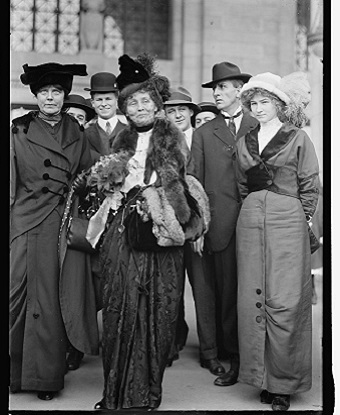Last updated: March 9, 2022
Person
Emmeline Pankhurst

Courtesy of the Library of Congress, https://www.loc.gov/resource/hec.03440/
Emmeline Pankhurst was one of the most famous and influential British suffrage leaders. Her embrace of protest and direct action in the early 1900s marked a new phase in the battle for women’s votes.
Fourteen-year-old Emmeline Goulden attended a public meeting about women’s rights in Manchester, England in the early 1870s. By the time she left it, she had become “a conscious and confirmed suffragist.” This work continued throughout her life. She and her husband Richard Pankhurst, a strong supporter of women’s rights, were active in early British suffrage groups. They pushed not only for the vote but also for equality for women in divorce and inheritance law.
By the early 20th century, Pankhurst had become frustrated with British political parties’ inaction on suffrage. She founded the Women’s Social and Political Union (WSPU) in 1903 to take militant action. The group targeted any political party that did not work towards votes for women.
The WSPU’s motto was “deeds, not words.” Pankhurst and her supporters attracted attention through their confrontational actions. They got themselves arrested and imprisoned for civil disobedience. In prison, several of them went on hunger strikes and endured brutal force-feedings. Others interrupted cabinet meetings and heckled politicians. Some activists even set fires in mailboxes and vacant houses.
Pankhurst and the WSPU had a significant influence on the American suffrage movement. While in graduate school in England, Alice Paul and Lucy Burns met Emmeline Pankhurst and her daughters, Christabel and Sylvia. The pageantry of WSPU marches—the banners, trumpets, coordinated chants, and military-style march organization—inspired them. Paul and Burns began attending English suffrage demonstrations and were arrested several times in 1909.
Paul and Burns brought these ideas and tactics home to the United States, organizing the 1913 Woman Suffrage Procession and the "Silent Sentinels" pickets outside the White House. They also borrowed the English strategy of a single-issue focus on winning suffrage. The organization they founded, the Congressional Union (later the National Woman’s Party), pushed for a constitutional amendment.
Emmeline Pankhurst also influenced the American suffrage movement through speaking tours. In 1909, Harriot Stanton Blatch (a suffragist and the daughter of Elizabeth Cady Stanton) sponsored her tour through the Northeast, where she spoke in Boston, New York City, and Geneva, New York.[1] She returned in 1913. During a stop in Hartford, Connecticut, she delivered perhaps her most famous speech, “Freedom or Death.” Pankhurst defended the British suffragettes’ militancy. She argued that it was the only option for forcing the government to recognize women’s rights.
“You won your freedom in America when you had the revolution, by bloodshed, by sacrificing human life,” she reminded her audience. “You have left it to women in your land, the men of all civilized countries have left it to women, to work out their own salvation. That is the way in which we women of England are doing. Human life for us is sacred, but we say if any life is to be sacrificed it shall be ours; we won't do it ourselves, but we will put the enemy in the position where they will have to choose between giving us freedom or giving us death.”
Suffragettes won a partial victory in 1918 when the United Kingdom granted propertied women over thirty the right to vote. Pankhurst continued to work for women’s empowerment, though her politics grew less radical. She committed herself to anti-communism, defended British imperialism, and became a member of the Conservative Party late in life. Despite ill health, Pankhurst lived to see suffrage extended to women on the same terms as men in England, Wales, and Scotland in 1928. She died that year at the age of 69.
Notes
[1] Pankhurst spoke at several historic venues during her speaking tours in the United States. In 1909, she spoke at Carnegie Hall in New York City (NRHP, October 15, 1966; NHL, December 29, 1962) and at the Smith Opera House in Geneva, NY (NRHP, October 10, 1979).
Bibliography
Bartley, Paula. Emmeline Pankhurst. London: Routledge, 2002. https://awpc.cattcenter.iastate.edu/2017/03/09/freedom-or-death-part-1-nov-13-1913/.
Pankhurst, Emmeline. "Freedom or Death," 1913.
Pankhurst, Emmeline. My Own Story, 1914.
Philpott, Susan. "Suffragette & Suffragist: The Influence of the British Suffrage Movement." The Suff Buffs Blog. https://www.womensvote100.org/the-suff-buffs-blog/2020/5/20/suffragette-suffragist-influence-of-british-suffrage-movement
Purvis, June. Emmeline Pankhurst: A Biography. London: Routledge, 2002.
Article by Ella Wagner, Cultural Resources Office of Interpretation and Education.
